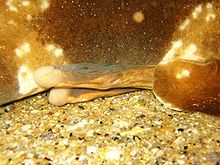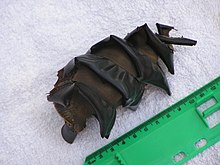
The claspers of male spotted wobbegong
Reproduction
Unlike most bony fishes, sharks are K-selected reproducers, meaning that they produce a small number of well-developed young as opposed to a large number of poorly developed young. Fecundity in sharks ranges from 2 to over 100 young per reproductive cycle. Sharks mature slowly relative to many other fish. For example, lemon sharks reach sexual maturity at around age 13–15.Sexual
Sharks practice internal fertilization. The posterior part of a male shark's pelvic fins are modified into a pair of intromittent organs called claspers, analogous to a mammalian penis, of which one is used to deliver sperm into the female.Mating has rarely been observed in sharks. The smaller catsharks often mate with the male curling around the female. In less flexible species the two sharks swim parallel to each other while the male inserts a clasper into the female's oviduct. Females in many of the larger species have bite marks that appear to be a result of a male grasping them to maintain position during mating. The bite marks may also come from courtship behavior: the male may bite the female to show his interest. In some species, females have evolved thicker skin to withstand these bites.
Asexual
There are two documented cases in which a female shark who has not been in contact with a male has conceived a pup on her own through parthenogenesis. The details of this process are not well understood, but genetic fingerprinting showed that the pups had no paternal genetic contribution, ruling out sperm storage. The extent of this behavior in the wild is unknown, as is whether other species have this capability. Mammals are now the only major vertebrate group in which asexual reproduction has not been observed.Scientists assert that asexual reproduction in the wild is rare, and probably a last ditch effort to reproduce when a mate is not present. Asexual reproduction diminishes genetic diversity, which helps build defenses against threats to the species. Species that rely solely on it risk extinction. Asexual reproduction may have contributed to the blue shark's decline off the Irish coast.
Brooding
Sharks display three ways to bear their young, varying by species, oviparity, viviparity and ovoviviparity.
The spiral egg case of a Port Jackson shark
0 comments:
Post a Comment